Carlsbad Caverns NP
Tuesday, Thursday May 1st &3rd, 2007I’ve visited the caverns twice before – once as a teenager with my parents, another as I moved to the San Francisco in my early thirties, a move that ultimately resulted in me meeting Denise. Looking back for a few wistful moments, I envied those earlier versions of myself - primarily for their youth and for adventures yet to come. But I value the experience, balance and happiness that time has brought me, along with the ability to look at the caverns again, this time thru the lens of my young son’s impressions. The third time’s a charm they say, and this trip certainly was for me. The caverns felt more real and intimate on this trip – perhaps due to the amount of time we spent at Carlsbad, rather than simply a quick loop around the Big Room, the main attraction of the cave and the only part that most people ever see.
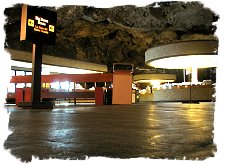 You have a choice of entrances to the caverns – the Natural Entrance, or via elevator. It’s rather discouraging to see how many people opt for the elevator, avoiding a steep downhill walk. However, I think it detracts from the experience of the cave, as the elevator route plops you out suddenly in the middle of a lunch room/gift shop/rest area 800 feet underground.
You have a choice of entrances to the caverns – the Natural Entrance, or via elevator. It’s rather discouraging to see how many people opt for the elevator, avoiding a steep downhill walk. However, I think it detracts from the experience of the cave, as the elevator route plops you out suddenly in the middle of a lunch room/gift shop/rest area 800 feet underground.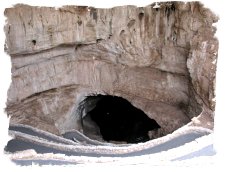 The Natural Entrance, although about an hours walk, allows you to gradually become attuned to the cave’s surroundings – first by descending into the maw of the cave’s entrance, continuing downward as the entrance light gradually diminishes, and then doubling back under into a long passageway that continues the 800 ft descent under ground. Combined with the many excellent information stations on the route, when you do reach the point where the elevators discharge their hordes of passengers, you feel like you are in a cave, not a branch of Disneyland! Although I can understand avoiding the Natural Entrance for health reasons or lack of time, I highly recommend it otherwise.
The Natural Entrance, although about an hours walk, allows you to gradually become attuned to the cave’s surroundings – first by descending into the maw of the cave’s entrance, continuing downward as the entrance light gradually diminishes, and then doubling back under into a long passageway that continues the 800 ft descent under ground. Combined with the many excellent information stations on the route, when you do reach the point where the elevators discharge their hordes of passengers, you feel like you are in a cave, not a branch of Disneyland! Although I can understand avoiding the Natural Entrance for health reasons or lack of time, I highly recommend it otherwise.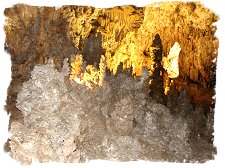 The Big Room, as mentioned before, is the part of the caverns that most visitors view. One of the largest natural open spaces underground in the world, the Big Room is rather unique in the amount of ornamentation it hosts, a wild variety of stalactites, stalagmites, and other wonders. The room is nearly ¾ of a mile long, with the height reaching several hundred feet in places.
The Big Room, as mentioned before, is the part of the caverns that most visitors view. One of the largest natural open spaces underground in the world, the Big Room is rather unique in the amount of ornamentation it hosts, a wild variety of stalactites, stalagmites, and other wonders. The room is nearly ¾ of a mile long, with the height reaching several hundred feet in places.Because of the dim lighting, it’s nearly impossible to take any decent photographs – most of the postcards and posters of the caverns were taken years ago, using monstrous racks of flashbulbs, including the largest flashbulb array ever set off. The sheer size of the room, and the fantastic assortment of shapes to view are nearly overwhelming...hence my Disneyland comment for those individuals who come down the elevator.
Stalactites and Stalagmites are formed by water slowing dripping thru small faults in the rock, slowly depositing minerals previously absorbed. ‘Wetter’ caves therefore have more formations, and the growth rate is dependent on the geology surrounding the cave, and the amount of rainfall. Amazingly, and saddening, is the discovery that the pools in the cave, although more than 800 feet down, are showing signs of contamination by surface elements – antifreeze,, motor oil, and even caffeine from soft drinks. This discovery has prompted some uncomfortable rethinking about the effect of surface activity on groundwater drinking supplies everywhere, as the conventional wisdom has been that much less ground than the 800 feet between Carlsbad and the surface would suffice to filter out any ground pollution.
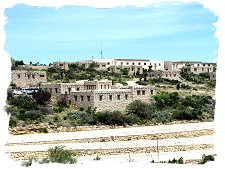 The Visitors Center, Park Housing and several parking lots sit right on top of the cave, and the Park Service is removing one of the parking lots, and will be gutting the Visitors Center starting in just a couple of weeks. Along with updating the Visitor Center (which isn’t very good at present), the infrastructure will be redone, including all plumbing, in order to minimize impact on the Caverns below. This summer might not be the best time to visit, because the Visitors Center and all concessions will be run out of a series of portable trailers until the renovations are completed.
The Visitors Center, Park Housing and several parking lots sit right on top of the cave, and the Park Service is removing one of the parking lots, and will be gutting the Visitors Center starting in just a couple of weeks. Along with updating the Visitor Center (which isn’t very good at present), the infrastructure will be redone, including all plumbing, in order to minimize impact on the Caverns below. This summer might not be the best time to visit, because the Visitors Center and all concessions will be run out of a series of portable trailers until the renovations are completed.The obvious question is why not move the Visitor Center off the top of the cave? The answer lies in the fact that Carlsbad Caverns are far not alone – there are over 100 known caves within the park boundaries. Moving the Visitor Center elsewhere would most likely impact another cave – known or unknown. Ideally, the Park Service would like to move the center and parking outside of the present park (off the ridge that contains the caves), but this would require purchase or donation of other property, and there is no budget for this activity.
There is an audio guide offered for the Natural Entrance and Big Room, and we all learned a lot. I’m pleased to say Vance learned enough about how the caverns were formed that he was able to correct Denise and me when we got it wrong a couple of days later. The cave offered a great opportunity for an introduction to geology in the area, and a dose of history and natural history.
A example of things we learned, see if you can answer the following:
Carlsbad Caverns were formed by:
• (A) Rock dissolved by acids, which were formed when gases bubbled up from underlying oil and gas deposits
• (B) Underground rivers, which dissolved the surrounding limestone
• (C) Volcanic activity
• (D) Rock eating bacteria doing their thing for millions of years
The correct answer is (A), which is unusual. Carlsbad is what is considered a ‘waterless’ cave. 95% percent of caves are formed via water flowing underground, but Carlsbad was hollowed out by the creation of sulfuric acid as a side effect of gases rising from oil and natural gas deposits below the cave. The surrounding area is full of oil derricks. Carlsbad has many large rooms whose only openings are tiny holes, which doesn’t make sense in a cave carved out by water (something like Mammoth Cave, for example). The acid leaching theory helps explain how these large rooms were formed without large entrances or exits (or any at all, for that matter).
Rock eating bacteria does exist, btw…in the lower cave regions, and in newly discovered caves where access is strictly controlled to scientific and mapping expeditions, bacteria has been found that eats rock for its nourishment. This plus the fact the microbes live in total darkness, has led to a redefinition of where life can be found. NASA has been studying the cave systems in Carlsbad NP to help determine how and where to look for microbe life on Mars, particularly as cave systems were discovered there very recently.
We went to Carlsbad on two different days, in order to accommodate a couple of Ranger led tours. Carlsbad offers a variety of tours, for easy, child appropriate walks, to several that require extensive climbing and crawling thru tight spaces. These tours require reservations, and even out of season our Left Hand Tunnel Tour had to be booked for three days after we arrived in the area. The moral of the story here is to book these tours online ahead of time if you are going to visit Carlsbad.
Our first tour was the King’s Palace tour that takes you thru several spectacular rooms full of formations. These rooms used to be open to the public on the main self guided tours, but too much damage was occurring, so now access is limited to the Ranger Tours. Part of the tour is a ‘blackout’, where all lights are turned off, and you experience complete, total darkness. It’s an eerie experience, as you literally can’t even see your hand right in front of your face. Vance got a little worried before the blackout (although he’s been in another one in Mammoth Cave), but enjoyed it once he realized nothing bad was going to come of it.
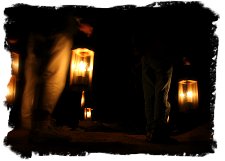 The other tour we took, with an interesting twist, was the Left Hand Tunnel tour. This is a candlelight lantern tour, harking back to the original exploration of the caverns by Jim White, a 16 year old local cowboy. White mapped out about ½ of the currently known caverns using only a small oil lantern that he made from his coffee pot! Left Hand Tunnel has been highly impacted by man – extensively mined for dirt used for trails in the other sections of the cave, and during the Cold War, as a storage area for Fallout Shelter supplies (a failed idea, because the cave ‘breathes’, replenishing it’s air on a frequent basis. This would pull radioactivity right into the cave – one big reason we don’t have the fallout shelters today much of anywhere – they wouldn’t work).
The other tour we took, with an interesting twist, was the Left Hand Tunnel tour. This is a candlelight lantern tour, harking back to the original exploration of the caverns by Jim White, a 16 year old local cowboy. White mapped out about ½ of the currently known caverns using only a small oil lantern that he made from his coffee pot! Left Hand Tunnel has been highly impacted by man – extensively mined for dirt used for trails in the other sections of the cave, and during the Cold War, as a storage area for Fallout Shelter supplies (a failed idea, because the cave ‘breathes’, replenishing it’s air on a frequent basis. This would pull radioactivity right into the cave – one big reason we don’t have the fallout shelters today much of anywhere – they wouldn’t work).The Ranger leading the tour was very knowledgeable about the history and geology of the cave. The cave systems sits within what at one time was an ocean reef, and it’s a wild
experience to view seashell fossils 800 feet underground! The tour via lantern light gives a whole new aspect to the cave, as you only have the flickering candlelight to see by. The tour is considered an off trail tour, as the footpaths are only marked off by orange tape (or striped hazard tape, for places to avoid), unlike the normal, paved trails in the publicly accessible portions of the cavern.
The lantern tours may not continue in the future – there is some discussion within the Park Service that the residue given off by the burning candles may impact the cave too much. While this may sound silly, the Park Service regularly vacuums the cave pathways, removing hundred of pounds of lint and dead skin cells. The lint impacts the cave formations, as well as skin oils, so you are reminded constantly not to touch any cave formations.
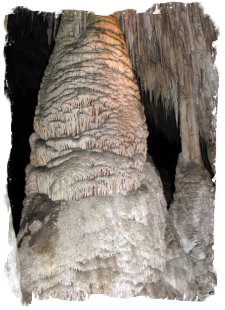 We finished out visit underground with a walk around the Big Room. Vance particularly liked the Hall of Giants, a series of huge columns. He also liked the last formations on the self guided tour, the ‘Chinese Theater’.
We finished out visit underground with a walk around the Big Room. Vance particularly liked the Hall of Giants, a series of huge columns. He also liked the last formations on the self guided tour, the ‘Chinese Theater’.Finally, no visit would be complete without a viewing of the bats. Carlsbad is home to a population of 350,000-500,000 bats. The bats have just recently returned from their winter migration, and their numbers will increase as babies are born. The park has an amphitheater located right above the Natural Entrance of the cave for viewing the bats when they leave the caverns at dusk.
This is an amazing sight – for 30 mins (later an hour as the numbers increase), the bats rise from the cave in what looks like a brown tornado. The bats circle in a counterclockwise motion until they rise above the cave entrance, then held off in a southwest direction for their nightly feeding.
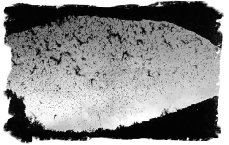 The Park Service has installed microphones in the cave that pick up the sounds of the bat’s echolocation systems (they use sound in a manner similar to sonar to find their way around). Because these signals are ultrasonic, they are frequency shifted to a sound that humans can hear. This roaring sound alerts everyone that the bats will make their appearance shortly.
The Park Service has installed microphones in the cave that pick up the sounds of the bat’s echolocation systems (they use sound in a manner similar to sonar to find their way around). Because these signals are ultrasonic, they are frequency shifted to a sound that humans can hear. This roaring sound alerts everyone that the bats will make their appearance shortly.The moon, only one evening from being full, rose above the horizon just as the first bats appeared. The view of thousands of bats clustered across the face of the moon was simply breathtaking. On the other side of the sky, a thunderstorm rumbled in the distance over the mountain peaks, providing a magical context for the bat flight.
One final note, which I learned reading a book about the first atomic bomb test at Trinity Site in New Mexico. The natural radioactivity in the caverns is high enough that the Park Service limits the amount of time its rangers and concession can spend in the cave. On one of our tours the Ranger made a cryptic comment about “Am I glowing yet?”, which now makes sense! However, the natural radioactivity (also contained in Granite – Grand Central Station in New York, a granite building, is also somewhat radioactive) is small, so infrequent guests are in no danger.

Vance: Carlsbad Caverns is amazing! It has neat stalagmites and stalactites. A stalactites hangs tight to the ceiling, a stalagmite grows mighty from the ground. When a stalagmite and a stalactite meet, it is a column. I even know a secret about the cave.
I took a candlelight tour in the Left Hand Tunnel. Did you know bats can live in the deeper sections of the cave? There is one chamber called the Big Room. A part of the chamber has a hole called the Bottomless Pit. No, it wasn’t bottomless. A spot in the Big Room was called the Chinese theatre!
The park even has bat flight programs. You can see the bats fly out of the cave entrance as they go look for food from dusk to dawn!
THIS WHOLE SERIES OF HUNDREDS OF CAVERNS WAS FORMED BY SOMETHING CALLED SULFURIC ACID!
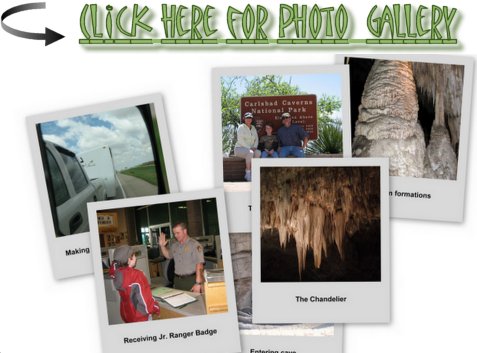
| Previous - Desert Rain | | Home | Index | | A 1960s Family Road Trip - Next |







<< Home